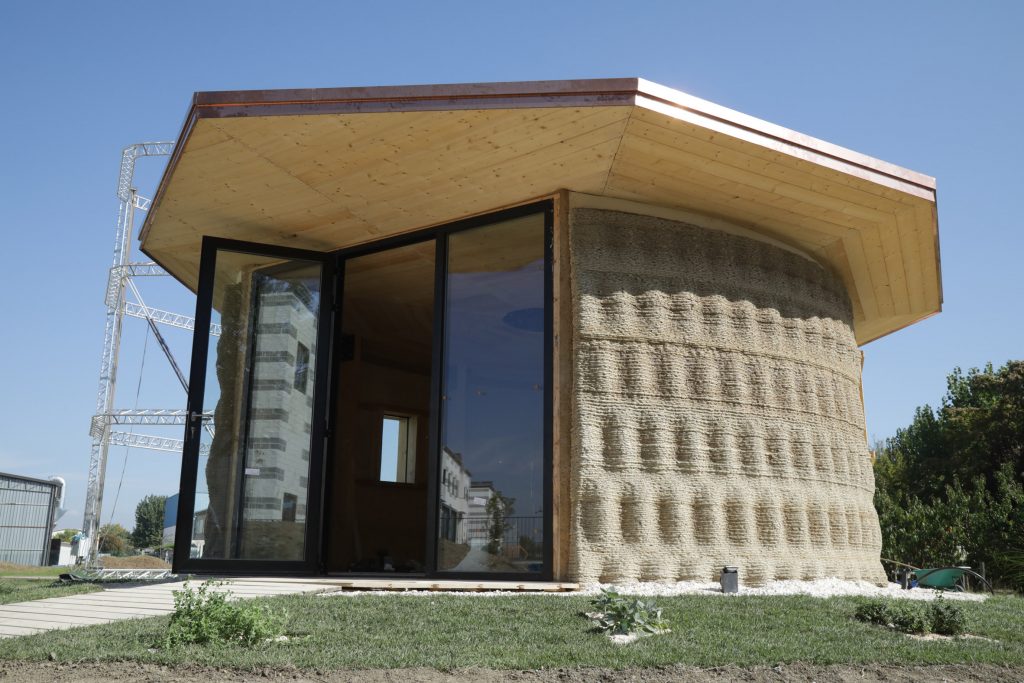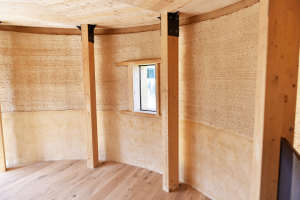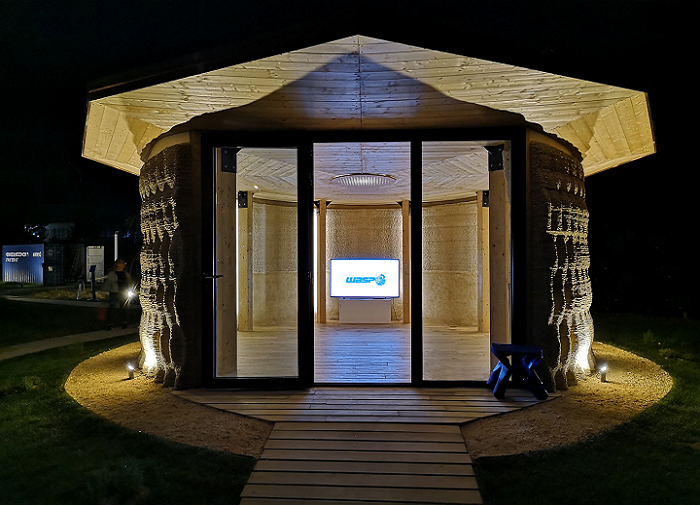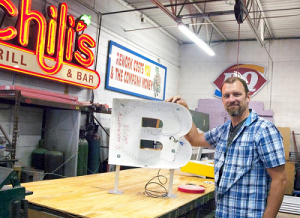3D Printing News Sliced: Titomic, Barclays, AMUG, Formnext + PM South China, Desktop Metal
Italy: WASP Engineers Make A Model Tiny Home Partially Out of 3D Printed Waste
We’ve have been following WASP for years, along with keeping tabs on progress at the village of Shamballa, a small and extremely progressive Italian community featuring homes fabricated with impressive, large-scale 3D printers. If you want a glimpse into what can be expected, look at Gaia, a model with an outer shell and beams constructed from organic material like soil and agricultural waste. The home measures 30 square meters (just over 320 square feet) and is on site at Massa Lombardo, at Shamballa, in the Emilia-Romagna region of Italy.
Although 3D printing has been a tremendous boon to myriad industries manufacturing parts and prototypes created from an ever-expanding range of plastics and metals, many users have delved deep into the study of material sciences—and ways to use the technology that are environmentally friendly. The 3D printing materials for Gaia were created from a biodegradable recipe of mud at the Shamballa site, plus waste from rice farming like straw and husks used for their natural insulating qualities.
“Gaia is the result of a limited and optimized use of agricultural resources, which through technology have been converted into a complex building with a minimal environmental footprint,” the WASP development team explained in a recent interview.
“If the building isn’t maintained, it will turn back into soil,” said WASP regarding the small home.
The technique and resourcefulness used in this project demonstrate the potential for diversified materials usage in 3D printing and construction overall; in fact, waste materials from a widely produced commodity like rice can be turned into insulation so effective that it may reduce or eliminate the use of other heating methods during the colder months in Italy.
“It is possible to conceive a future scenario in which one hectare of cultivated paddy field can become 100 square-meters of built environment,” WASP said.
Empty pockets are created within the walls allowing for ventilation and efficiency overall. Husks were also used in the roofing materials for further warmth and protection. The most intrinsic benefits of 3D printing in construction are on display with this model home that cost less than a thousand pounds to make and was completed in only ten days. And while the benefit of ‘making less waste’ is highly touted, here the team is using waste; also, the WASP team believes numerous other natural waste materials could become useful in construction around the world.
“Gaia is a highly performing structure in terms of energy, with almost no environmental impact,” said the WASP development team.
3D printing in construction is a topic that gets builders, developers, and consumers at every level excited because of the true potential it has for changing nearly every process of the building and even selling process; in fact, in some cases, building a home via 3D printing may become an inexpensive DIY process leading not only to opportunities to anyone with the wherewithal to assemble a small construction, but also continuing to add to options for developing countries and areas in need of housing during disaster relief. Builders today have already used 3D printing for off-the-grid smart homes, tiny homes, pods, and other protective structures, even including bus stop shelters. Find out more about WASP and their ongoing 3D printing projects here.
What do you think of this news? Let us know your thoughts! Join the discussion of this and other 3D printing topics at 3DPrintBoard.com.
[Source / Video and Images: Dezeen]
WASP Launching Long-Term ‘3D Printing for Sustainable Living’ Construction Project
In September, WASP, or the World’s Advanced Saving Project, debuted its new Crane construction 3D printer, in Italy. It’s actually a modular 3D printing system, or “infinity 3D printer,” with different configurations to choose from, and was presented to the public in Massa Lombarda, where the 3D printed village of Shamballa is being constructed.
In October, a two-day program was held, starting with a conference titled “A call to save the world,” surrounding the introduction of WASP’s Crane 3D printer and its innovative 3D printed Gaia Module. The livable, tiny 3D printed house is the first structure that the WASP Crane 3D printed, and was made out of actual raw earth, with straw and rice husks added to the interior for insulation.
“Everyone in the world will have a fine, healthy, sustainable, self-sufficient and ecological home for birthright,” WASP wrote in a press release. “The earth is our witness, took form in Gaia.”
Now that the 3D printed architectural Gaia model is complete, WASP is beginning a brand new technological phase “in view of Expo 2020,” and kicking things off in 2019 with a long-term program called “3D Printing for Sustainable Living.”
GAIA represents an important case study for understanding just what’s possible when using 3D printing in the construction industry. The 3D printed earth module is an important part of WASP’s new program, which focuses on developing construction process using digital fabrication and 3D printing in an effort to move towards an all-new concept of building houses.
“As already announced in the conference “A Call to save the World”, WASP runs for a collaboration with partners belonging to every sector, from architectural design to the university research, from humanitarian associations to national ministries, able to fully share the project,” the company wrote. “It proposes a strategic program of constructive activities, expressly designed for on-site 3D printing and developed through the use of local raw materials.”
The program centers around an advanced, eco-sustainable model of construction, especially due to the lower cost and higher interior comfort the walls in the Gaia model provide with their combination of raw earth and natural waste as construction materials.
Some of the partners expected to work with WASP on its new project include a few universities, humanitarian associations, banking institutions and foundations, both public and private authorities, and several ministries, including Education, Health, Environment and Protection of Land and Sea, Infrastructure and Transport, Labor and Social Policies, Foreign Affairs and International Cooperation, Food and Forestry Agricultural Policies and Tourism, and Economic Development.
 The project is based on six main macro-areas, starting with the promotion of human and material resources from the territory. This area features the capitalization of human knowledge, the use of renewable energy sources and materials found on site, the democratization of technology for the purposes of production, and using local manpower, rather than people with advanced training.
The project is based on six main macro-areas, starting with the promotion of human and material resources from the territory. This area features the capitalization of human knowledge, the use of renewable energy sources and materials found on site, the democratization of technology for the purposes of production, and using local manpower, rather than people with advanced training.
The second project area is sustainable construction processes with low environmental impact, including such items as lowering construction costs, CO2 emissions, the use of concrete, and transport operations, as well as using natural waste and better planning out the construction life cycle. Recycled materials, like natural waste from the agricultural chain and rubble, make up the third area, while the fourth is centered around the digitalization of the construction site through features such as digital data acquisition through 3D scanning, site monitoring, using on-site measuring to lower the amount of mistakes, and constantly defining the correct spatial coordinates.
Multi-purposes construction is the fifth project macro-area, which includes coordinating the use of multiple methods of digital fabrication like CNC technology, embedding supply facilities during initial construction rather than after, adding natural ventilation and thermal insulation right onto the walls, and using controlled material deposition to achieve high performance construction. Digital design is the final project area, and will focus on features including integrated design with BIM software, sharing digital contents available on the Internet, using a material optimization algorithm for construction, and making construction projects fully digital.
With this new project, WASP hopes to become a leader in the housing market, due also to its network of collaborators that will help to foster and share the project. The company knows that are some real opportunities in the future for green building, and also plans to develop a new eco-district in order to implement its “3D Printing for Sustainable Living” project goals and set up new constructive strategies that can be replicated in multiple environments.
Discuss this news and other 3D printing topics at 3DPrintBoard.com or share your thoughts in the Facebook comments below.
[Images provided by WASP]
3D Printing News Sliced, Formnext 2018, ExOne, Stratasys, DyeMansion, America Makes, DSM
3D Printing News Sliced: TRUMPF, Renishaw, Stratasys, Banksy
3D Printing News Briefs: September 27, 2018
We’re starting with some news from the ongoing TCT Show in today’s 3D Printing News Briefs, and then moving on to webcasts and YouTube videos, finishing with an update on the upcoming Viaggio a Shamballa event by WASP. At the TCT Show, AMFG has unveiled its new Supplier Integration Network. An applications engineer from Fisher Unitech conducted a webcast about using Lean Six Sigma Manufacturing to optimize additive manufacturing, a Technical University of Denmark professor talked about the possibilities of topology optimization for 3D printing, and a Boeing engineer discussed 3D printing in the aeronautics industry. Finally, we’re getting ever closer to the date that WASP will publicly present its Crane construction 3D printer, and the village it’s building, in Massa Lombarda, Italy.
AMFG Introducing Supplier Integration Network at TCT Show
 At the TCT Show, which continues in Birmingham through this Thursday, AM automation software provider AMFG is unveiling the newest feature in its software platform: the Supplier Integration Network, which lets manufacturers coordinate their AM supply chain network and automate production. With the Supplier Integration Network, manufacturers can outsource production or post-processing to their suppliers, and suppliers and service bureaus can use it to give OEMs easier access to their services. The company believes that this latest feature will make its portfolio more attractive to manufacturers looking to invest in 3D printing.
At the TCT Show, which continues in Birmingham through this Thursday, AM automation software provider AMFG is unveiling the newest feature in its software platform: the Supplier Integration Network, which lets manufacturers coordinate their AM supply chain network and automate production. With the Supplier Integration Network, manufacturers can outsource production or post-processing to their suppliers, and suppliers and service bureaus can use it to give OEMs easier access to their services. The company believes that this latest feature will make its portfolio more attractive to manufacturers looking to invest in 3D printing.
“Manufacturers are looking to scale their additive production effectively and we’re committed to giving them the software infrastructure to do so. Facilitating greater connectivity between all players along the supply chain, through automation, is a large part of this,” said Keyvan Karimi, CEO of AMFG. “Our vision with the Supplier Integration Network is also to help companies achieve truly distributed manufacturing by providing a greater level of connectivity along the supply chain through our platform. Of course, the Supplier Integration Network feature is designed to be used in conjunction with our other AM solutions, from project management to production planning and more.”
To see this new automation platform for yourself, visit AMFG at Stand J42 at the TCT Show.
Fisher Unitech Webcast: Optimizing Additive with Lean Six Sigma Manufacturing
 3D printer and 3D product development software provider Fisher Unitech, a distributor of MakerBot and Nano Dimension 3D printers, is on a mission to advance manufacturing in America by supporting, delivering, and training customers on the best software and manufacturing solutions. Recently, Gerald Matarazzo, a 3D Printing Application Engineer with the company, as well as a Certified Lean Six Sigma Green Belt, recorded a webcast all about using the Lean Six Sigma methodology to optimize additive manufacturing. During the webcast, Matarazzo introduces viewers to some Lean Six Sigma best practices, tips, tools, and tricks to help 3D printing companies stop getting hung up on costly delays.
3D printer and 3D product development software provider Fisher Unitech, a distributor of MakerBot and Nano Dimension 3D printers, is on a mission to advance manufacturing in America by supporting, delivering, and training customers on the best software and manufacturing solutions. Recently, Gerald Matarazzo, a 3D Printing Application Engineer with the company, as well as a Certified Lean Six Sigma Green Belt, recorded a webcast all about using the Lean Six Sigma methodology to optimize additive manufacturing. During the webcast, Matarazzo introduces viewers to some Lean Six Sigma best practices, tips, tools, and tricks to help 3D printing companies stop getting hung up on costly delays.
“I want to be very clear – this presentation is meant for managers, not analysts,” Matarazzo explains in the webcast. “What that basically means is, once again, we’re going to be going over management tools, optimization, and tips and tricks on how to better manage a team or better manage a fleet of machines.”
Watch the 30-minute webcast below to learn more:
Topology Optimization Possibilities for 3D Printing
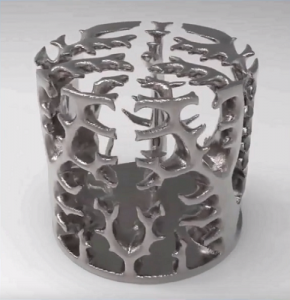 In a new YouTube video posted by Simuleon, a reseller of Dassault Systèmes SIMULIA products, you can see an interview with Ole Sigmund, a professor at the Technical University of Denmark (DTU) and the keynote speaker at Dassault’s Additive Manufacturing Symposium, which opened this year’s popular Science in the Age of Experience event. Sigmund is one of the inventors of topology optimization, a mathematical approach that optimizes material layout within a given design space. It allows designers to take advantage of the geometrical freedoms possible through 3D printing. In the video, Sigmund discusses the possibilities of topology optimization, and infill technologies, for additive manufacturing.
In a new YouTube video posted by Simuleon, a reseller of Dassault Systèmes SIMULIA products, you can see an interview with Ole Sigmund, a professor at the Technical University of Denmark (DTU) and the keynote speaker at Dassault’s Additive Manufacturing Symposium, which opened this year’s popular Science in the Age of Experience event. Sigmund is one of the inventors of topology optimization, a mathematical approach that optimizes material layout within a given design space. It allows designers to take advantage of the geometrical freedoms possible through 3D printing. In the video, Sigmund discusses the possibilities of topology optimization, and infill technologies, for additive manufacturing.
“So essentially additive manufacturing offers ultimate freedom for manufacturing but they don’t know how to come up with these optimal parts. And on the other hand, topology optimization uses this ultimate freedom to come up with parts that are optimized for specific load cases and extreme situations. And so topology optimization provides the designs to additive manufacturing and additive manufacturing makes it possible to realize the designs coming from topology optimization, so that is an ideal marriage.”
3D Printing in the Aeronautics Industry
 At this summer’s EAA Oshkosh AirVenture aviation event in Wisconsin, Boeing structures researcher Bernardo Malfitano delivered an hour-long talk about the use of 3D printing in the aeronautics industry. Understanding Airplanes recently published the YouTube video of the talk, along with the presentation slides. The Boeing researcher’s talk discussed the history of aviation companies using common 3D printing methods like SLA and FFF, how the the technology is currently used in the aerospace industry, and the ongoing research that will introduce even more applications in the future, such as surface smoothing and fatigue testing. The presentation also shows dozens of 3D printed parts that are currently in use on aircraft by companies and organizations like Boeing, Airbus, Lockheed Martin, and NASA.
At this summer’s EAA Oshkosh AirVenture aviation event in Wisconsin, Boeing structures researcher Bernardo Malfitano delivered an hour-long talk about the use of 3D printing in the aeronautics industry. Understanding Airplanes recently published the YouTube video of the talk, along with the presentation slides. The Boeing researcher’s talk discussed the history of aviation companies using common 3D printing methods like SLA and FFF, how the the technology is currently used in the aerospace industry, and the ongoing research that will introduce even more applications in the future, such as surface smoothing and fatigue testing. The presentation also shows dozens of 3D printed parts that are currently in use on aircraft by companies and organizations like Boeing, Airbus, Lockheed Martin, and NASA.
“I should probably specify that this isn’t really 3D printing for home builders, because I’m mostly gonna talk about more advanced technologies and more expensive 3D printers,” Malfitano said at the beginning of his talk. “I’m gonna talk about 3D printers that can print metal parts that cost millions of dollars.”
You can watch the whole presentation in the video below:
Viaggio a Shamballa Event by WASP Coming Soon
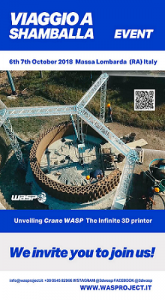 The versatile Italian company WASP, or the World’s Advanced Saving Project, has spent the last two years developing a new large-scale construction 3D printer called the Crane, a modular system consisting of multiple print bodies that’s evolved from the BigDelta 12M. In less than two weeks, WASP will be presenting the Crane to the public in Massa Lombarda, which is where the village of Shamballa is being 3D printed. On October 6th and 7th, a program will be held surrounding the introduction of the WASP Crane 3D printer and the Gaia Module 3D printed earth house. The conference “A call to save the world” will open the event, focusing on future 3D printing construction developments and proposing themes for reflection on both design strategy and the technology’s potential in architecture.
The versatile Italian company WASP, or the World’s Advanced Saving Project, has spent the last two years developing a new large-scale construction 3D printer called the Crane, a modular system consisting of multiple print bodies that’s evolved from the BigDelta 12M. In less than two weeks, WASP will be presenting the Crane to the public in Massa Lombarda, which is where the village of Shamballa is being 3D printed. On October 6th and 7th, a program will be held surrounding the introduction of the WASP Crane 3D printer and the Gaia Module 3D printed earth house. The conference “A call to save the world” will open the event, focusing on future 3D printing construction developments and proposing themes for reflection on both design strategy and the technology’s potential in architecture.
“Knowledge applied to common good. If we use digital manufacturing techniques to respond to the basic human needs, we start up a real hope and this will be the guiding thread of “A call to save the world”. A home is undoubtedly a primary need and WASP’s mission has always been to develop processes and tools to allow men, wherever they are, to build 3D printed houses with material found on site and at a cost that tends to zero,” WASP wrote in a press release.
“The WASP call is addressed to all those who want to collaborate and spread the new construction techniques, with the final aim to create a better world. Representatives of international organizations involved in architectural research, such as IaaC (Institute Advanced Architecture Catalunya, ES), XtreeE (FR), D-Shape (IT), Emerging Objects (USA), will take part in the meeting.”
Check out the complete program here.
Discuss these stories and other 3D printing topics at 3DPrintBoard.com or share your thoughts below.
3D Printing News Briefs: September 18, 2018
We’re starting with a bit of business news in today’s 3D Printing News Briefs, then a story about metal 3D printing, and then moving along with examples of some of the amazing and innovative things people have been making with this technology. Sigma Labs has issued a letter to shareholders about some company changes, and a YouTube video introduces some new hard tool steels for 3D printing. WASP is carrying on with a major project by its Crane construction 3D printer, and a University of Minnesota professors talks about 3D printing electronics directly on skin. BMW Motorrad created 3D printed motorcycle components, and a Wisconsin sign company is using 3D printing for its products. Finally, Wrights Robotics made a full-sized, 3D printed, talking robot from a little 1980s movie called Short Circuit, and a low poly artist made some neat 3D printed chain mail.
Sigma Labs Says Goodbye to Mark Cola
This past Friday, September 14th, Sigma Labs, Inc., which provides quality assurance software under the PrintRite3D brand, announced that its President, Co-Founder, and CTO Mark Cola would be retiring next month. After the news had time to settle over the weekend, the company announced the release of a letter to its shareholders from CEO and Chairman John Rice. In the letter, Rice paid tribute to everything Cola had done for the company over the years, and also assured shareholders “that the succession taking place is smooth and secure,” noting that Cola’s internal management responsibilities will be covered by Sigma’s Vice President of Engineering Darren Beckett, while Dr. Martin Piltch will take over his role on the company’s outside team of technology consultants.
“We thank Mark as founder and a leader of Sigma Labs, for creating and driving a vision of advancing the Additive Manufacturing Industry’s ‘good’ 3D manufacturing technology to become a ‘great’ high-quality manufacturing technology assured by Sigma’s IPQA,” the letter reads. “We shareholders can thank Mark for building and leading the multi-discipline technology team that is commercializing our robust data-rich analytical and interactive software – hardware tools that promise to add real value to an industry that needs such a tool. Yes, Mark now surely has the right to step back. Thank you and well done, Mark Cola!”
Here at 3DPrint.com we’ve met with Mark and have been very impressed with his deep 3D Printing knowledge and his vision on 3D printing for manufacturing and know he’ll be sorely missed at Sigma Labs.
Hard Tool Steels for SLM 3D Printing
 Formetrix Metals, a brand new company I’d not heard of before today, recently posted its first video about its use of BLDRmetal steel alloys for laser powder bed fusion 3D printing. The 3D printable hard tool steel was used to make industrial dies for rolling bolt threads, after the dies made with CNC machining had failed.
Formetrix Metals, a brand new company I’d not heard of before today, recently posted its first video about its use of BLDRmetal steel alloys for laser powder bed fusion 3D printing. The 3D printable hard tool steel was used to make industrial dies for rolling bolt threads, after the dies made with CNC machining had failed.
After designing the dies, new BLDRmetal tool steel was used to 3D print prototypes. Once the surface finish was complete on the prototype dies, they were able to achieve high toughness and a high case hardness of up to 74 HRC.
WASP Crane Construction 3D Printing
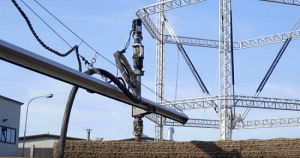 WASP (World’s Advanced Saving Project) is well-known for its large-scale construction 3D printers, and for the last two years has been working to develop a new one, called the Crane or “the infinity 3D printer.” Evolved from the BigDelta 12M, the Crane is a modular 3D printing system with different configurations to choose from. Next month in Italy, WASP plans to present the Crane to the public in Massa Lombarda, which is where the village of Shamballa is being 3D printed.
WASP (World’s Advanced Saving Project) is well-known for its large-scale construction 3D printers, and for the last two years has been working to develop a new one, called the Crane or “the infinity 3D printer.” Evolved from the BigDelta 12M, the Crane is a modular 3D printing system with different configurations to choose from. Next month in Italy, WASP plans to present the Crane to the public in Massa Lombarda, which is where the village of Shamballa is being 3D printed.
On October 6th and 7th, a program will be held surrounding the introduction of both the WASP Crane 3D printer and the Gaia Module, a 3D printed earth house. According to WASP, Gaia is “the first module in soil ever realized with the 3d print- technology.” For more information on the event, visit the WASP website. You can see the new Crane 3D printer in action below:
3D Printing Electronics on Skin
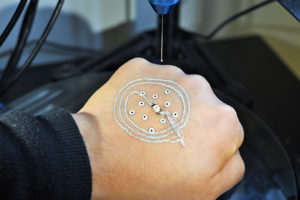 While augmenting humans with electronics that can monitor our vitals, enhance our senses, and provide us with real-time information may sound like just an episode out of new science fiction series Glimpse, from Futurism Studios and DUST, the idea of advanced wearable electronics is not so far-fetched. Researchers like Michael McAlpine, a 3D printed electronics expert and mechanical engineering professor at the University of Minnesota, are working to improve upon existing technologies to make this fantasy a reality. This spring, McAlpine published a study that demonstrated how to 3D print electronics directly onto skin with an inexpensive, self-made 3D printer and ink made from silver flakes. Recently, Futurism interviewed McAlpine about his research, and his thoughts on the future of 3D printable electronics.
While augmenting humans with electronics that can monitor our vitals, enhance our senses, and provide us with real-time information may sound like just an episode out of new science fiction series Glimpse, from Futurism Studios and DUST, the idea of advanced wearable electronics is not so far-fetched. Researchers like Michael McAlpine, a 3D printed electronics expert and mechanical engineering professor at the University of Minnesota, are working to improve upon existing technologies to make this fantasy a reality. This spring, McAlpine published a study that demonstrated how to 3D print electronics directly onto skin with an inexpensive, self-made 3D printer and ink made from silver flakes. Recently, Futurism interviewed McAlpine about his research, and his thoughts on the future of 3D printable electronics.
“All of these technologies we’re developing will lead to the post-computer era. You’re basically going from 2D to 3D [microchips to integrated circutry], which is essentially what biology is. So, that’s where the merger of electronics and biology is going to happen. Any privacy or ethical issues that spring from that aren’t going to be much different from the ones that we have with current electronics,” McAlpine said.
3D Printed Motorcycle Components
 The motorcycle brand of German automotive company BMW, called BMW Motorrad, recently developed a new motorcycle that’s full of 3D printed components and parts. This is not surprising, considering the parent company’s love for and use of 3D printing for both its regular and concept automobiles – BMW has been using 3D printing to build its cars for nearly 28 years.
The motorcycle brand of German automotive company BMW, called BMW Motorrad, recently developed a new motorcycle that’s full of 3D printed components and parts. This is not surprising, considering the parent company’s love for and use of 3D printing for both its regular and concept automobiles – BMW has been using 3D printing to build its cars for nearly 28 years.
3D printing can achieve parts with complex geometries, which is why it’s a perfect technology for the automotive industry. BMW Motorrad’s special concept motorcycle, called the S1000RR, demonstrates how the company can build new components using rapid prototyping technologies, as it is made of many 3D printed parts, such as a swingarm and an aluminum chassis. Take a look for yourself in the video below:
3D Printing Signs: Beneficial or Not?
Four years ago, a sign making company called Fastsigns decided to adopt 3D printing in three of its major markets – Chicago, Milwaukee, and San Diego. Fastsigns isn’t the only company to use 3D printing to make signage – a Milwaukee business called Sign Effectz, which was first founded in the company president’s garage in 1996 and now resides in a 17,000-square-foot facility, decided to explore 3D printing a few years ago, because it could open new ways of customizing signs and make it simpler and less expensive to produce small batches of custom products. But, workers in skilled trades may not appreciate the technology quite as much.
“Your fabricators on the floor now turn into (computer-aided design) modelers. I did. I love it. I came from busting my knuckles and dropping stuff on my toes and wasting material to problem solve and figure out how to build something… to getting to the 3D CAD modeling world where you can do all of that stuff in a virtual world and make sure 1,000 pieces all match and align and run it through animation to see if it works,” said Adam Brown, the President of Sign Effectz, before noting the potential downside of the technology.
“I wonder if you’ll be able to maintain the level of interest and passion in 3D CAD modeling because there’s little pain associated with it all of the sudden. It’s just a mental math problem and you hit print.”
In my opinion, products like custom signage are one of the many applications for which 3D printing is perfect. Using 3D design and CAD software to create signs is still a creative way to build something, even if you’re not manufacturing every bit of the sign by hand.
Full-Size 3D Printed Johnny 5 Robot
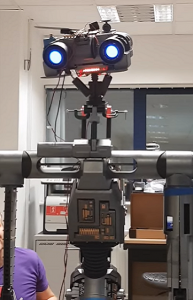 If you’re a fan of 80s movies, then you surely know of Short Circuit, starring such well-known actors of the decade like Steve Guttenberg and Ally Sheedy. With the tagline “Life is not a malfunction,” the movie tells the story of Number 5, one of a group of experimental military robots. When the robot is struck by lightning and electrocuted, he suddenly gains self-awareness and intelligence, and flees the laboratory, as he is afraid of being reprogrammed. He is later rechristened as Johnny 5.
If you’re a fan of 80s movies, then you surely know of Short Circuit, starring such well-known actors of the decade like Steve Guttenberg and Ally Sheedy. With the tagline “Life is not a malfunction,” the movie tells the story of Number 5, one of a group of experimental military robots. When the robot is struck by lightning and electrocuted, he suddenly gains self-awareness and intelligence, and flees the laboratory, as he is afraid of being reprogrammed. He is later rechristened as Johnny 5.
Wrights Robotics recently completed its own life-size, 3D printed version of the Johnny 5 robot, and published a YouTube video showing its audio, neck motor, and lip light tests. Just like the real Johnny 5, this 3D printed robot moves, lights up, and talks, even uttering the movie phrase “Don’t disassemble Number 5!”
3D Printed Chain Mail
Do you know what’s cooler than designing and 3D printing your own chainmail? Playing with it!
pic.twitter.com/s7k3jfzVSE
— Agustin Flowalistik (@flowalistik) September 15, 2018
If you’re a frequent visitor to Renaissance festivals, then you’ve no doubt seen plenty of chain mail in your day. But Agustin Flowalistik, a low poly 3D printing artist based in Madrid and the Fablab manager of Tecnolab, decided to create his own chain mail – of the 3D printed variety, of course. If you want to make your own, Flowalistik has made the files available for download at Cults3D, Thingiverse, and MyMiniFactory.
“The chainmail size is 195x195mm. A 60x60mm sample is available to test and find the right settings before printing the big chainmail. Print the model with a 0.4mm nozzle and 0% infill,” Flowalistik wrote in the Thingiverse description for the 3D printable chainmail.
Discuss these stories and other 3D printing topics at 3DPrintBoard.com or share your thoughts below.


